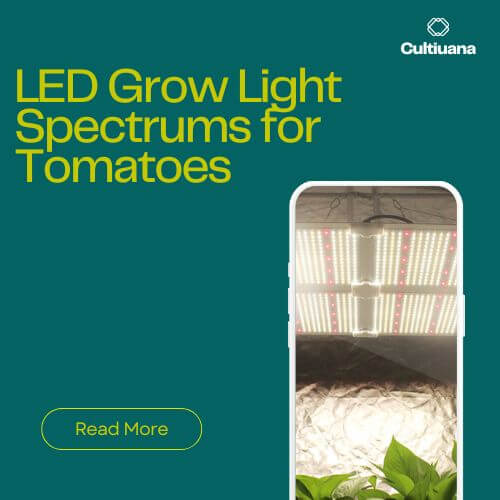LED Grow Lights: Light Wavelengths, Temperature Colors and Actual Wattage
Since we have lots of questions and much confusion with the light wavelengths, temperature colors and actual wattage of LED grow lights, we decided to write a blog to try to explain a bit more:
LED Grow Lights Light Wavelengths
LED grow lights are a type of grow lighting that uses light emitting diodes to provide the light source. They are the most efficient and environmentally friendly type of grow light available.
The spectrum is measured in nanometers (nm), which is a unit of measure for wavelengths of electromagnetic radiation. Grow indoor medical plants require light ranging from 400 to 700 nanometers.

The different wavelengths have different effects on plant growth.
Blue wavelength: Blue wavelengths are the most efficient for photosynthesis and can penetrate the soil deeper than any other color. This means there is more energy available for plant growth and development.
Red wavelength: Red wavelengths are necessary for photosynthesis as well, but not as much as blue wavelengths. They also help plants with flowering and fruiting. Green wavelength: Green wavelengths help with chlorophyll production, which helps plants absorb energy to produce food through photosynthesis.
Yellow wavelength: Yellow wavelengths help with flowering in some species of plants, like roses, but they don't have any other benefits when it comes to plant growth and development.
Orange wavelength: Orange wavelengths are similar and only helpful for plants where green wavelengths produce the best results, like roses.
Infrared wavelength: Infrared wavelengths have no benefit in photosynthesis or plant growth, but they can help prevent frost damage.
Your plants need light from the right part of the spectrum with the right amount of intensity to encourage proper yet fast growth.
They will primarily react to light at the blue end of the spectrum (420nm to 550nm) for vegetative growth and at the yellow, amber, and red end for root growth and flowering (550nm to 750nm).
HPS lights can provide plants with the light in the yellow-red spectrum. That's why it's so popular for growing medical plants, as it helps in flowering and budding.

MH lights give light from about 350-550 nanometers (nm) in the blue, green to yellow range. Depending on the specific brand, however, some HPS lamps are 'cooler' and some MH lamps are 'warmer'.
MH lights are better for the vegetative stage, but may not work for the final flowering/bud stage.
LED grow lights are able to emit different diodes of LED light together, typically blue, red, and green. Manufacturers choose these diode colors based on what's closest to the spectrum of sunlight, so as to make their product as true-to-life as possible.
The best LEDs include a balance of lights from both the cool spectrum and the warm spectrum, with plenty of stable whites.
With the right type of light and some maintenance, you'll be able to grow successfully from seed to harvest with one light, producing astonishing results above 1 gram per Watt.
When it comes to electricity usage, LED grow lights run on around 50% of the power when compared to the same HPS grow light.
With a 500 Watt (true draw) LED grow light, for example, you can get the same results as a 1000 Watt HPS unit.
LED bulbs use much less energy, create less heat, have no need for ballasts, and can last more than 50,000 hours.
The Temperature Colors of LED Grow Lights and What is Kelvin?
Every light source has a particular color in its spectrum measured in nanometers (nm), say 400 to 700 nm. The lower the Kelvin degree (K), the more warm, or red the light appears.
As the temperature of a light increases, the degree (K) gets higher and it appears more blue, or cooler. Kelvin is a scientific term that is used to describe how blue or cool a light is.

Put more simply, it is a measurement of the degree of warmth or coolness of a light source. It doesn't take into account physical temperature, but rather its appearance.
Each metal halide (MH) grow light is approximately 3,200 to 5,500K while high pressure sodium (HPS) grow lights are approximately 2,200K and full spectrum LEDs have a mix of blues, reds, and whites, etc.
LEDs often combine blue and red lights. They can work well on the plants, but it's better if they look like white light, which makes it look like the sun.
Difference Between Advertising Wattage and Wattage That's Actually Used

All LED grow lights typically run below their possible power - an example of 100 x 3-watt LEDs might only need a power draw of 150 watts, or lower.
If you want LEDs to last a long time, running them at 50-65% of their capacity is a good idea. If you continuously run at full power, the color quality and life will change for the worse.
Say your LED grow light has 150 x 1W LEDs. Would you think it has 150 watts of power output? No, because if you always power the bulb at full load it will shorten its life.
Generally speaking, an LED grow light will produce between 55 and 65% of its full power; similarly, if you see a 450 watt light advertised with 150 x 3 watt LEDs, its actual consumption will be about 250 watts. Using the volts, amps, and watts calculator, you can calculate the actual output or draw of any LED grow light.
Grow light manufacturers often do not specify how many volts or amps the lamp uses, so if they don't tell you, then assume they're running at 60% capacity.




